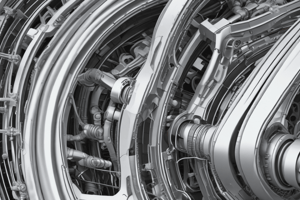Podcast
Questions and Answers
أي مما يلي يعتبر من عيوب الصب؟
أي مما يلي يعتبر من عيوب الصب؟
- عدم دقة الأبعاد (correct)
- ضعف مقاومة المواد المصبوبة (correct)
- صعوبة تشكيل أشكال معقدة
- عدم إمكانية الحصول على سلسلة من القطع المتطابقة
- ضعف مقاومة المواد المصبوبة في درجة حرارة عالية
- صعوبة التحكم في دقة الأبعاد (correct)
- ارتفاع تكلفة الإنتاج
- إمكانية حدوث عيوب في القطع (correct)
ما هو العيب المرتبط بعملية الصب ، والذي يتطلب مراجعة دقة الأبعاد بعد عمليات الصب؟
ما هو العيب المرتبط بعملية الصب ، والذي يتطلب مراجعة دقة الأبعاد بعد عمليات الصب؟
- العيوب السطحية
- التشوه الجانبي
- التجاويف
- التقلص (correct)
ما هو الصب وما هي أنواع الصب؟
ما هو الصب وما هي أنواع الصب؟
عملية تُستخدم لصنع القطع من المواد المصبوبة ، مثل المعادن ، والبلاستيك ، وغيرها من المواد المصبوبة. تُقدم هذه العملية مجموعة من الأنواع المختلفة ، مثل الصب في الرمال ، و الصب في القالب ، و الصب في القوالب ، وغيرها من الأنواع.
ما هو الهدف من عملية الصب؟
ما هو الهدف من عملية الصب؟
ما هي المواد المستخدمة في عملية الصب؟
ما هي المواد المستخدمة في عملية الصب؟
ما هي العمليات التي تُستخدم في عملية الصب؟
ما هي العمليات التي تُستخدم في عملية الصب؟
هل الصب عملية اقتصادية ، تُستخدم في صناعة السيارات؟
هل الصب عملية اقتصادية ، تُستخدم في صناعة السيارات؟
ما هي المواد التي تُستخدم في صناعة السيارات عن طريق الصب؟
ما هي المواد التي تُستخدم في صناعة السيارات عن طريق الصب؟
Flashcards
ما هو المفهوم الأساسي للمواد؟
ما هو المفهوم الأساسي للمواد؟
يُشير مصطلح "المواد" إلى أي مادة تُستخدم لتصنيع جسمٍ بشكلٍ عام.
ما هي أنواع المواد في مجال علم المواد؟
ما هي أنواع المواد في مجال علم المواد؟
في مجال علم المواد، يُشير مصطلح "المواد" إلى مادة تُستخدم لتصنيع منتجاتٍ محددة مثل الماء والهواء والرمل.
ما هو الرمز المميز للعناصر الكيميائية في السبائك؟
ما هو الرمز المميز للعناصر الكيميائية في السبائك؟
عُرفت في السابق باسم رموز "المواد المعدنية" التي تُستخدم للدلالة على العناصر الكيميائية في السبائك.
ما هي السبائك المعدنية التي يتم تشكيلها عن طريق التشويه؟
ما هي السبائك المعدنية التي يتم تشكيلها عن طريق التشويه؟
Signup and view all the flashcards
ما هو نظام تصنيف سبائك الألومنيوم المُخصصة للتشكيل؟
ما هو نظام تصنيف سبائك الألومنيوم المُخصصة للتشكيل؟
Signup and view all the flashcards
ما هو معنى الرقم الأول في نظام تصنيف سبائك الألومنيوم؟
ما هو معنى الرقم الأول في نظام تصنيف سبائك الألومنيوم؟
Signup and view all the flashcards
ما هي الاستخدامات الرئيسية لسبائك الألومنيوم؟
ما هي الاستخدامات الرئيسية لسبائك الألومنيوم؟
Signup and view all the flashcards
ماذا يُشير نظام تصنيف سبائك الألومنيوم المُخصصة للصب؟
ماذا يُشير نظام تصنيف سبائك الألومنيوم المُخصصة للصب؟
Signup and view all the flashcards
ماذا يُشير الرقم الأول في نظام تصنيف سبائك الألومنيوم المُخصصة للصب؟
ماذا يُشير الرقم الأول في نظام تصنيف سبائك الألومنيوم المُخصصة للصب؟
Signup and view all the flashcards
ما هي الاستخدامات الرئيسية لسبائك النحاس؟
ما هي الاستخدامات الرئيسية لسبائك النحاس؟
Signup and view all the flashcards
ماذا يُشير مصطلح "الحديد الزهر"؟
ماذا يُشير مصطلح "الحديد الزهر"؟
Signup and view all the flashcards
ما هو الهدف الأساسي من عملية الصب؟
ما هو الهدف الأساسي من عملية الصب؟
Signup and view all the flashcards
ما هو المفهوم الأساسي لعملية الصب؟
ما هو المفهوم الأساسي لعملية الصب؟
Signup and view all the flashcards
ما هو دور القالب في عملية الصب؟
ما هو دور القالب في عملية الصب؟
Signup and view all the flashcards
ما هي طريقة الصب الأساسية؟
ما هي طريقة الصب الأساسية؟
Signup and view all the flashcards
ما هو المفهوم الأساسي للرمل المستخدم في عملية الصب؟
ما هو المفهوم الأساسي للرمل المستخدم في عملية الصب؟
Signup and view all the flashcards
ما هو مفهوم عملية "الطبق"؟
ما هو مفهوم عملية "الطبق"؟
Signup and view all the flashcards
ما هو مفهوم "طبْقَ الألواح"؟
ما هو مفهوم "طبْقَ الألواح"؟
Signup and view all the flashcards
ما هي الطريقة الأساسية في عملية "طبْقَ الألواح"؟
ما هي الطريقة الأساسية في عملية "طبْقَ الألواح"؟
Signup and view all the flashcards
ما هو مفهوم "عملية الطبق في قالب"؟
ما هو مفهوم "عملية الطبق في قالب"؟
Signup and view all the flashcards
ما هو مفهوم "عملية الدرفلة"؟
ما هو مفهوم "عملية الدرفلة"؟
Signup and view all the flashcards
ماذا يُشير "عملية التقطيع"؟
ماذا يُشير "عملية التقطيع"؟
Signup and view all the flashcards
ما هو مفهوم "التقطيع"؟
ما هو مفهوم "التقطيع"؟
Signup and view all the flashcards
ما هي الطريقة "التقطيع" لإنتاج الأسطح؟
ما هي الطريقة "التقطيع" لإنتاج الأسطح؟
Signup and view all the flashcards
ما هي "آلات التقطيع"؟
ما هي "آلات التقطيع"؟
Signup and view all the flashcards
ما هو دور "أدوات التقطيع"؟
ما هو دور "أدوات التقطيع"؟
Signup and view all the flashcards
ما هي "أدوات الحفر"؟
ما هي "أدوات الحفر"؟
Signup and view all the flashcards
ما هي "دقة التقطيع"؟
ما هي "دقة التقطيع"؟
Signup and view all the flashcards
ما هي "سلسلة العمليات"؟
ما هي "سلسلة العمليات"؟
Signup and view all the flashcards
ما هي "المرحلة" في "سلسلة العمليات"؟
ما هي "المرحلة" في "سلسلة العمليات"؟
Signup and view all the flashcards
ما هي "وضعية التثبيت"؟
ما هي "وضعية التثبيت"؟
Signup and view all the flashcards
ما هي "طريقة التثبيت"؟
ما هي "طريقة التثبيت"؟
Signup and view all the flashcards
ما هو دور "طريقة التثبيت" في تحديد الأبعاد؟
ما هو دور "طريقة التثبيت" في تحديد الأبعاد؟
Signup and view all the flashcards
ما هي "اتفاق المرحلة"؟
ما هي "اتفاق المرحلة"؟
Signup and view all the flashcards
ما هو مفهوم "الأداة الحفر"؟
ما هو مفهوم "الأداة الحفر"؟
Signup and view all the flashcards
ما هو دور "الأداة الحفر" في تحديد "شكل" "الثقب"؟
ما هو دور "الأداة الحفر" في تحديد "شكل" "الثقب"؟
Signup and view all the flashcards
Study Notes
General Information
- The document is a study guide titled "Polycopié de Technologie de Base"
- Prepared by Dr. Meziane El Hadj
- Compiled in November 2017
- Published by Hassiba Benbouali University of Chlef, Algeria
Chapter 1: Materials
- Introduces various materials used in engineering
- Categorizes materials into four main groups
- Explains that material properties are dependent on chemical nature, physical form & surface conditions
Chapter 1: a. Aluminum and Aluminum Alloys for Shaping
- Aluminum alloys for shaping are identified by 4-digit codes (e.g., 7075)
- These codes conform to the Aluminum Association's standards.
- The first digit corresponds to the principal alloying element.
- The second, third, and fourth digits assign specific variants of the alloy composition.
Chapter 1: b. Copper and Copper Alloys
- Copper alloys are identified using a standardized system.
- Examples of the standardized coding system are provided.
Chapter 1: c. Iron and Iron Alloys (Cast Irons)
- Specific types of cast irons are defined, including those with graphite in lamellar or spheroidal forms.
- The relevant European standards (EN) for different types of cast irons are mentioned (e.g., EN-GJL-350 for lamellar graphite iron).
- Mechanical properties (like tensile strength) are specified in the standards.
Chapter 1: d. Zinc and Zinc Alloys
- Zinc alloys (typically ZL) are common in die casting.
- Relevant compositions (e.g., ZL3, ZL5, and ZL2) and their uses (such as die casting) are mentioned.
Chapter 2: Processing Methods Without Removing Material
- Discusses various manufacturing methods that do not remove material from the workpiece
- Explains that the process selection depends on the type of material, required shape, and production scale.
- Includes discussion about casting methods (sand casting, die casting) and other important methods
- Covers the general principles of shaping or processing objects using methods like sand casting and die casting from a fluid or molten state.
Chapter 2: a. Sand Casting
- Explains that sand casting is a common method for shaping parts from molten metal.
- Details the components of a typical sand mold (e.g., upper and lower parts).
- Discusses the process involved in a typical sand casting operation.
Chapter 3: Processing Methods Removing Material
- Details methods that involve taking material away from a workpiece.
- Covers various machine tools and their operation.
Chapter 3: a. Definition and Generation of Surfaces
- Explains the concept of generating surfaces through movements of the tool (generatrix) and the workpiece
- Provides examples and classification of surface formats.
Chapter 3: b. Machine Tools
- Describes different types of machines used in machining, such as lathes and milling machines.
- Discusses the various axes and movements (e.g., rotation, translation) employed.
Chapter 3: c. Cutting Tools
- Describes different cutting tools like drills, taps, milling cutters
- Details the functions and characteristics of each tool
Chapter 3: d. Cutting Parameters
- Presents the crucial parameters for machining processes (e.g., cutting speed, feed rate, depth of cut)
- Highlights the critical relation between the factors.
Chapter 3: e. Operations
- Describes fundamental operations in different machining processes.
Chapter 3: f. Tooling
- Explains the various kinds of equipment, their properties and how they impact the operation.
Chapter 3: g. The Machining Process in Steps
- Presents the steps to produce a manufactured part.
- Explains the importance of pre-planning the steps required for manufacturing a product.
Chapter 3: h. The Phase, the Machining Schedule
- Discusses the sequence of operations essential to complete the manufacturing of a product.
- Highlights the importance of coordination among several phases.
Chapter 3: i. Parts Positioning
- Discusses the processes by which the parts are positioned accurately during manufacturing.
Chapter 4: Assembly Techniques
- Describes methods in assembling and joining parts together.
- Discusses various methods like bolting & riveting, brazing, soldering, and welding.
Chapter 4: a. Removable/Non-permanent Connections
- Covers screws, bolts and nuts.
- Explains how fasteners assemble two components securely.
Chapter 4: b. Permanent Connections
- Explains the use of rivets for permanent connections.
Chapter 4: c. Brazing
- Brazing method to join components.
Chapter 4: d. Welding
- Discusses the use of welding for permanent connections. This method usually uses heat or pressure or both.
References
- Lists sources used in the guide, providing citations for each source.
Studying That Suits You
Use AI to generate personalized quizzes and flashcards to suit your learning preferences.



